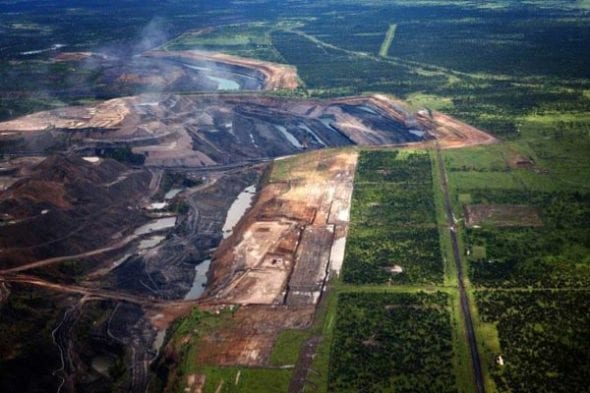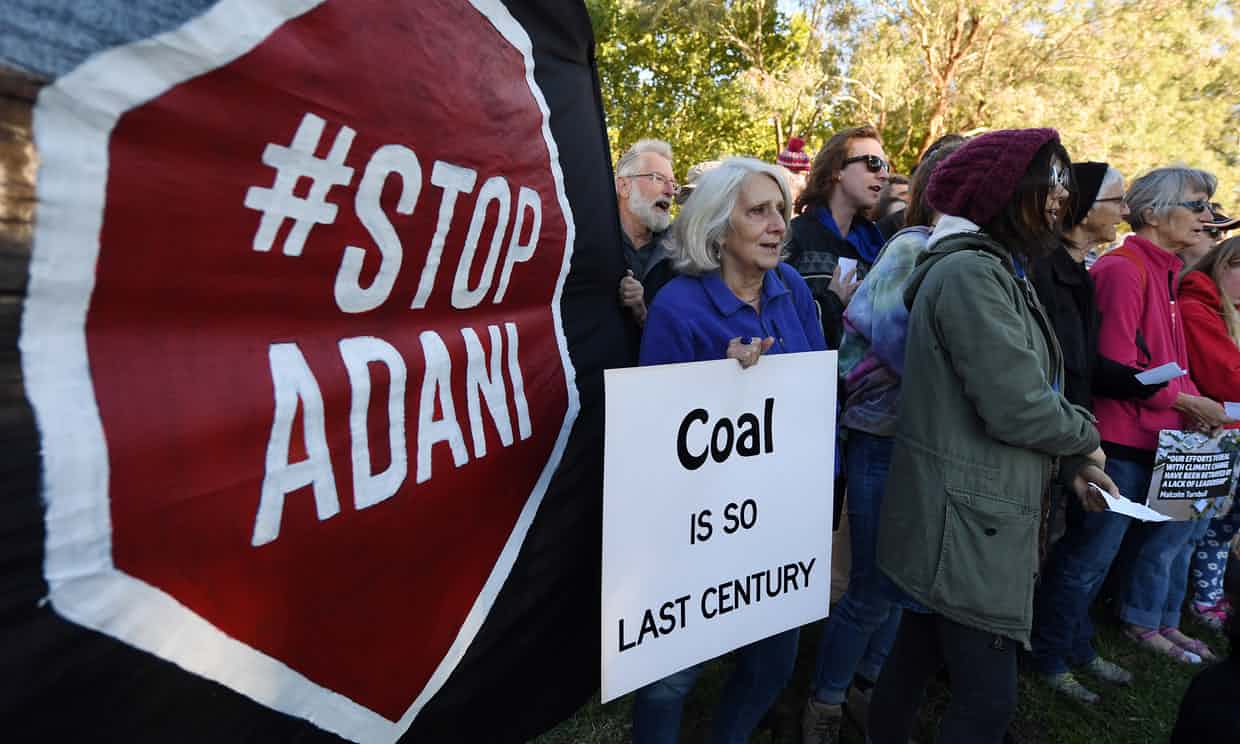
The invitation of an Adani Mining executive as a speaker at a “energy roundtable” in Hanoi organised by an Australian government agency is symptomatic of the desperate challenge the company faces getting its Carmichael coal project off the ground.
Adani Mining’s Senior Marketing Manager, Christine Evans, was listed by the Australian Trade Commission (Austrade) to speak on “future supply opportunities, international coal procurement practice” at the roundtable on May 22.
However, Evans had a meagre 10-minute allocation in what was undoubtedly little more than a brief door-opener for Adani Mining with potential buyers.
Her role at the conference is also testament to the Australian government’s determination to do all it can to help Adani, even though the company won’t mine or export a single tonne of its own coal from Australia anytime soon, if ever.
It also reflects the Australian Government’s hope of hustling some extra coal sales in Vietnam in spite of its stated support for the goals of the Paris Agreement.
Vietnam, which also supports the Paris Agreement, currently ranks as having the fourth largest amount of proposed coal plant capacity in the world.
With about 35,890 megawatts (MW) of coal plants at early stages of proposal and over 10,645 MW currently under construction, Vietnam is one of the few remaining growth markets for coal exporters.
As a rough rule of thumb, each 1000 MW of coal plant capacity consumes about 4 million tonnes of coal.
With potentially as much as 140 million tonnes of extra coal demand a year at stake if all the projects were built, major coal exporting countries are keen to ensure their companies are at the head of the supply queue.
But Adani and the Australian Government’s hopes for massive increases in coal exports to Vietnam may yet turn to dust.
Public opinion shifts away from coal
In Vietnam, public opinion has been shifting away from coal power and its associated pollution for several years.
In early 2015 residents near the recently built Vinh Tan 2 power station were so appalled by pollution from the plant they blocked a national highway for 30 hours demanding government action. (Public alarm over pollution from the plant continues to this day.)
A few months later the collapse of a coal mine tailings dam killed 17 people downstream in Cam Pha City. In the same storm floods washed coal stored at the Quang Ninh Thermal Power Plant into a river adjoining the Ha Long Bay World Heritage site.
More recently, public opposition by residents of Ho Chi Minh City to the proposed 2800 MW Long An plant prompted the local government to back siting the project elsewhere or re-designing it to run on LNG rather than coal.
In Hanoi, Vietnam’s capital city, air pollution is already bad. In 2017 residents had only 38 clean air days. As air quality in the city has deteriorated to rival Beijing’s, the national government has proposed the installation of air monitoring stations. Ongoing public concern over worsening air pollution is likely to force the national government to reassess its support for more coal plants.
Vietnam’s pollution problem and embrace of coal power has also attracted growing international attention. In early May one of the founders of Green Innovation and Development Centre (GreenID), Nguy Thi Khanh, was awarded the prestigious Goldman Environmental Prize for her clean energy advocacy work.
As public opinion has progressively hardened against pollution from coal mines and power stations, local and provincial governments are increasingly expressing their preference for clean energy projects.
Since 2010 30,700 MW of proposed coal plants in Vietnam have been cancelled with a further 2800 MW shelved.
More of the proposed coal plants are likely to follow. On a global basis, about two-thirds of all coal plants proposed since 2010 have never made it to the construction phase.
Vietnam’s government has long been enticed to support new coal plants with tempting offers from Japanese, South Korean and Chinese banks of subsidised loans on the condition of buying key components supplied by their respective national power plant manufacturers.
However, Vietnam’s government has gradually grown more wary of an over-reliance on coal power.
In early 2016 Vietnam’s former prime minister, Nguyen Tan Dung, signalled a reduced role for new coal-fired power stations in the country’s forthcoming power plans and an expanded role for renewable energy. In late 2017 Vietnam’s current prime minister acknowledged the need to limit the number of coal plants built in the Mekong Delta as they would “affect the long-term benefits of the region”.
With the national Power Development Plan set to be revised in 2018, further cuts to coal generation are possible. NGO groups in Vietnam are hopeful that 20,000 MW of proposed coal plants will be cut in the next plan.
Even though the cost of renewables has fallen dramatically in recent years Japan, China and South Korea are still peddling new coal plants.
However, there are encouraging signs that policies are slowly shifting. With new feed-in tariffs, many solar and wind projects are getting off the ground.
This week Vietnam’s Ministry of Finance proposed increasing the environmental tax on coal by between 30 and 50 percent depending on the grade of coal.
The ministry explained the aim of the proposed tax increase is to reduce carbon dioxide and other pollution and encourage a switch to cleaner fuels.
With domestic coal production plateauing, coal imports have climbed rapidly to feed the growing number of recently commissioned plants.
At a time of relatively high prices in the seaborne coal market, this has created a powerful financial incentive for national economic planners to reconsider plans for large numbers of new coal-fired plants.
At a conservative price of US$71 per tonne, a 1000 MW plant would require in the order of US$284 million a year for fuel alone. If all 36,000 MW of proposed plants were built, Vietnam would be paying well over US$10 billion a year for coal imports.
Over the 30-plus years normal lifespan of coal plants, the fuel costs would represent a massive drainon Vietnam’s economy.
The problem confronting lobbyists for Japan, South Korea, China and Australia is to persuade Vietnam’s government and citizens to spend billions on coal imports when they could build solar and wind capacity and spend nothing on fuel.
Ash everywhere
There’s one other factor running against coal in general and coal from Adani Mining’s proposed Carmichael mine in particular: coal ash.
One of the triggers for the public blockade of the national highway near the Vinh Tan 2 power station in early 2015 was widespread pollution caused by coal ash dumped in a landfill.
As Vietnam’s coal generation has increased steadily, so too has the volume of coal ash requiring disposal.
While requiring coal ash to be used as cheap fill in cement and other construction materials has been touted as a quick fix there are formidable practical problems. The sheer volume of ash generated is far greater than can be easily accommodated by existing cement and other plants.
Further complicating matters is that coal plants in the country’s south are a long way from existing brick and cement plants.
As controversy over coal ash pollution has grown, government officials have vowed to ensure stricter enforcement of pollution control standards.
Even though some plants have been recently built, little thought was given to what to do with coal ash.
For example, late last year it was estimated that the 2300 MW Mong Duong 1 plant in northern Vietnam could run out of storage capacity by May 2018 even though the plant was only commissioned in late 2015.
As the problems of what to do with coal ash have grown, groups close to the coal industry have argued pollution control standards should be relaxed.
Late last year the Thermal Science & Technology Association, a power industry advisory body to the Vietnamese Government, proposed that existing coal plants should be exempted from coal ash pollution standards.
It was a proposal that horrified scientists and civil society groups who argued for regulation of coal ash to protect public health and environmental quality.
For Adani the growing controversy over coal ash management in Vietnam puts them in a vulnerable position. Coal from Adani’s proposed Carmichael mine is not only of a far lower quality than most thermal coal in the seaborne market but it has 25–30 per cent ash content.
The prospect that already alarmed Vietnamese citizens will embrace more coal power is growing more tenuous by the month. The idea that Adani’s high-ash coal will find a ready long-term market sufficient to prop up an unfinancial mine looks downright fanciful.

May 27, 2018 at 7:19 pm
The people have made Adani step back. Now, he is trying to relieve himself from the company